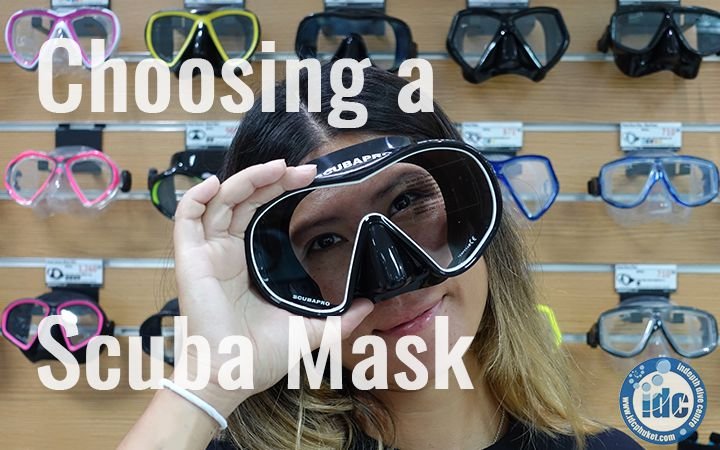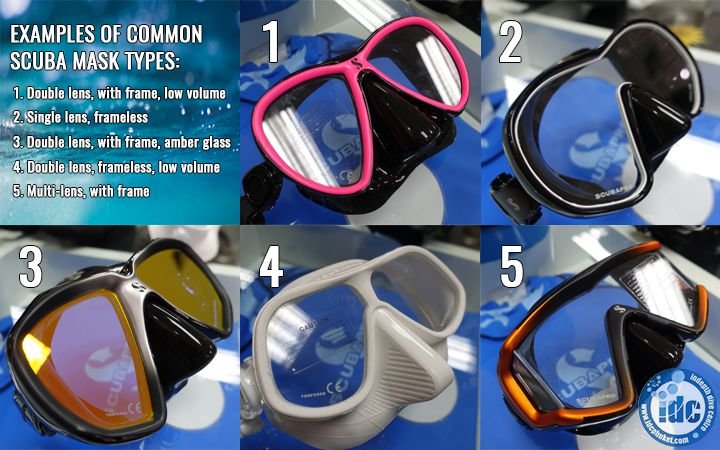Tips for Choosing a Scuba Diving Mask
A mask is what we call “personal diving equipment’, along with your snorkel and fins. Most divers decide to buy a scuba diving mask first as not only it is “cheap” compared to a regulator or dive computer, but also you should be choosing a mask because it is one of the most important pieces of dive equipment to own when it comes to having a relaxed and comfortable dive.
And of course, masks are light, compact, easy to travel with so you will have no problem taking it with you. And obviously, it is just as good for snorkeling on holiday as it is for scuba diving.
Purpose of a scuba diving mask
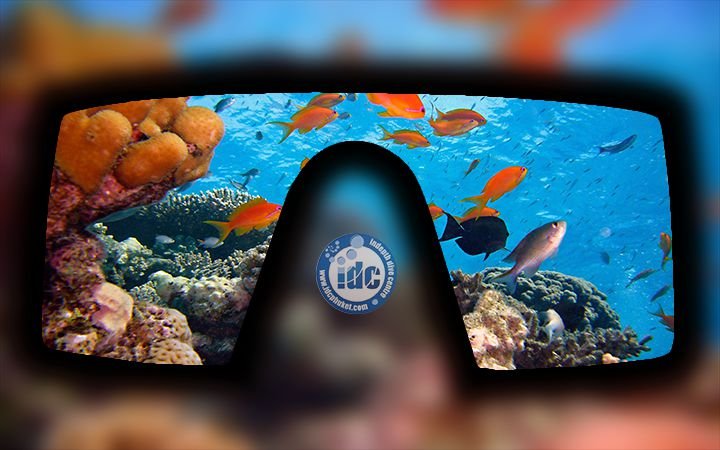
The purpose of a mask is to allow us to see clearly underwater. We have all opened our eyes underwater, and as we found out, we cannot see clearly. And your eyes probably stung as well. Therefore, all a mask does is provide an airspace in front of our eyes to allow us to see clearly underwater.
A perfect example of this was during your PADI Open Water Course when you learnt the skill “Mask removal and replacement.” There was a noticeably big difference between what you could see with and without your mask on.
Features of a scuba mask
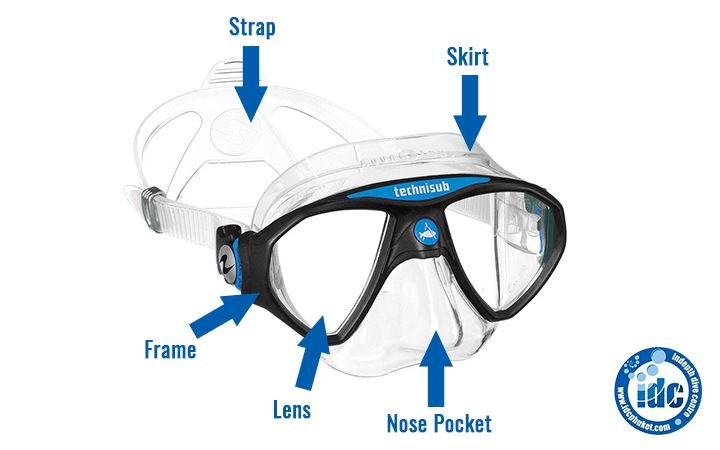
A mask consists of a plastic frame with one or two lenses, and a silicone mask skirt that forms a seal around your face. It also has a “nose pocket” which your nose “fits in” which allows you to pinch your nose and equalize. There is also an adjustable silicone strap to tighten or loosen your mask with.
The lens or lenses are made of tempered glass and are shatterproof. The lenses have been specially designed and tested to ensure they withstand the pressures involved at depth. Although to be honest we have never tried to smash a mask lens, but we have also never seen a lens crack.
Both the mask frame and skirt come in a variety of colours. A clear skirt and frame will permit more light penetration. A black skirt will instead reduce glare and side view distractions, in addition to having the extra benefit of not showing up dirt!
Note: when choosing a scuba diving mask, it is important to understand that “supermarket-style snorkel masks” are not suitable for scuba diving. Although fine for swimming in the shallows, they are made of cheaper materials that are not compatible with scuba diving. For example, they typically have plastic lenses, which would shatter at depth. We recommend buying only scuba masks from reputable and specialised manufacturers such as Scubapro, Aqualung, or other equally well-known brands.
Styles of a scuba diving mask
Single lens or double lens?
When choosing your scuba diving mask, keep in mind that masks generally fall into one of two styles:
A “single lens” mask which has one lens with no “divider” in the middle. This can help with “depth perception”, allow for easier equalizing and offers an uninterrupted view.
“Double lens” masks which have two separate lenses, the same as a pair of glasses, usually in a teardrop shape. If you are used to a single lens mask, then the first time you use one you may notice the “divider”. However, in our experience, after one or two dives you will not see any difference. As mentioned, these masks can be particularly useful for divers who wear glasses, as many manufacturers offer prescription lenses.
There isn’t really any difference, we have used both for decades. Most of our rental masks are double lens, as are the staffs. In the end, it comes down to which mask fits you best, irrespective of the style or price.
Choosing a scuba diving mask with a frame or no frame?
Traditional frame masks have a rigid design which will generally work better for people who struggle to find a good fit. Frameless designs put the lenses slightly closer to your eyes which can offer a wider view and lower volume, as well as meaning the mask can fold up flat and be easily stored.
Less common would be “multiple lens masks”, which have an additional ‘window’ in each side of the mask. This lets more light in and offers a wider field of vision. These can be a good option for divers who suffer from claustrophobia.
Full-Face Masks
Full-face Masks are generally used by professional / technical / commercial / scientific divers, usually with underwater voice communication. Although in 2016 PADI released their Full-Face Mask Course aimed at the recreational divers.
How to see if a scuba mask you are fits you properly?
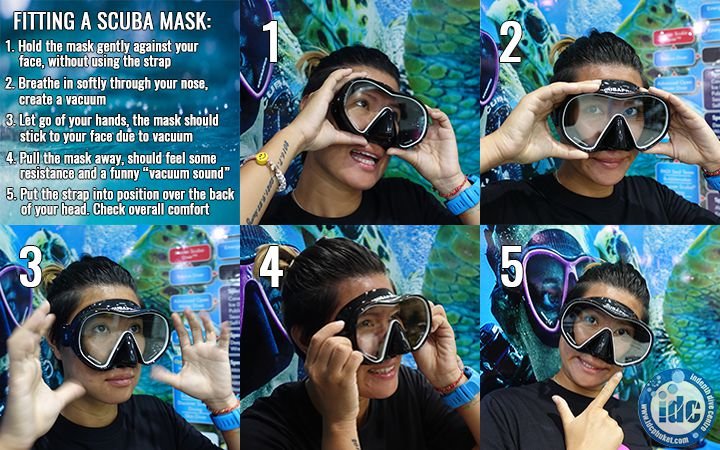
- Move your hair out of the way and hold the mask against your face without putting the strap over your head.
- Breathe in through your nose and should feel the mask “pulling onto your face” without any air escaping.
- Let go of the mask as it should be “stuck” to your face. It is normal to have a little bit of air escaping, but basically, it is stuck to your face.
- Now pull the mask away from your face it should feel resistance and often a kind of funny “vacuum sound”.
- Put the mask on your face again and put the strap over the back of the head. The mask should feel comfortable and should not cause discomfort. Something which can happen with some faces and masks is that the mask puts too much pressure on the bridge of your nose which is uncomfortable.
Preparing your mask for diving the first time
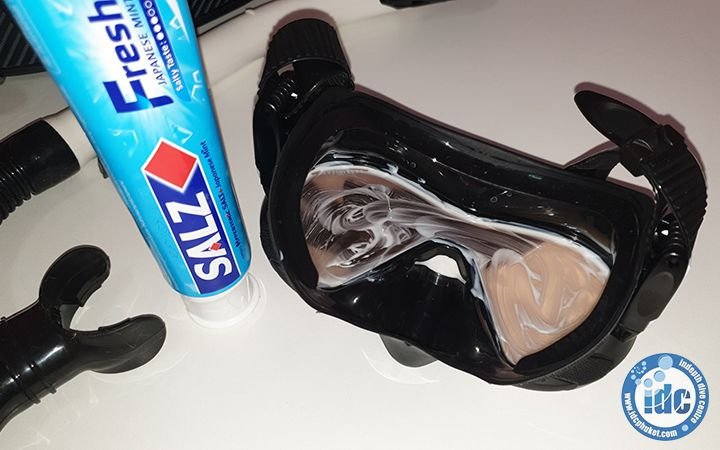
Before you use your mask for the first time there is something you need to do before you dive with it. This is because the manufacturing process leaves a thin protective layer of silicone on the inside of the lens. It is important to remove this layer of silicone otherwise your mask with keep fogging up as normal defogging methods will not work.
To remove the film, you will need to scrub the lens inside and out with a mild abrasive. A paste toothpaste (not a gel toothpaste, just your normal white toothpaste) is ideal. There are also various liquid scrubs. All you do is rub a little bit in the lens with your fingers and then rinse and clean thoroughly.
You may have to repeat this a couple of times. However, once the film has been removed then that’s that. From now on you only need to defog your mask as you would normally do prior to diving.
Scuba Diving Mask Defogging Methods
As you know from your PADI Open Water Course you need to defog your mask before each dive. These are the usual methods which we have used for the last 30 years.
Spitting: This is the easiest method which has been used for decades. All you do is spit into your mask, rub it around, and rinse it. “The greener the better” as we used to say. However, with the arrival of the COVID-19 virus, we are ALL better off using the other methods below.
Baby Shampoo: This has become extremely popular in the past 10 years, and many divers carry a bottle of watered-down baby shampoo with them. Simply add a few drops, rub around the lens and rinse. Most dive boats here on Phuket have these on the dive deck area. Incidentally, baby shampoo is preferable to “normal shampoo”, as it is usually hypo-allergenic, less irritating to your eyes, and biodegradable.
Commercial defoggers: these are obviously specifically designed to clean/prevent mask defogging and are easy to pick up from a dive shop or online. There is nothing wrong with these, and there plenty to choose from, we just think that baby shampoo is cheap and easy.
Post Dive Care and Maintenance
Leave it to soak in fresh water for 10-15 minutes to dissolve any salt crystals. Warm water is preferable, but not hot water, and then rinse it thoroughly with fresh water and dry before storing.
It is a good idea to store it in its original box somewhere dry and out of direct sunlight. If not in the box, then try and store it separated from your other dive equipment as its coloured pigmentation can discolour clear silicone skirts.
More posts about diving equipment:
- Choosing Dive Equipment
- All about snorkels
- Choosing the right fins
- Scuba Cylinders & Valves
- Buoyancy Control Devices (BCDs)
- How to choose a Scuba Regulator
- Breathing Gas Monitoring Devices
- Depth Monitoring Devices
- Scuba Diving Weights & Quick Release Weight Systems
- Choosing a wetsuit for Scuba Diving
- Audible Signaling Devices for Scuba Diving
- Choosing a Scuba Diving Compass



